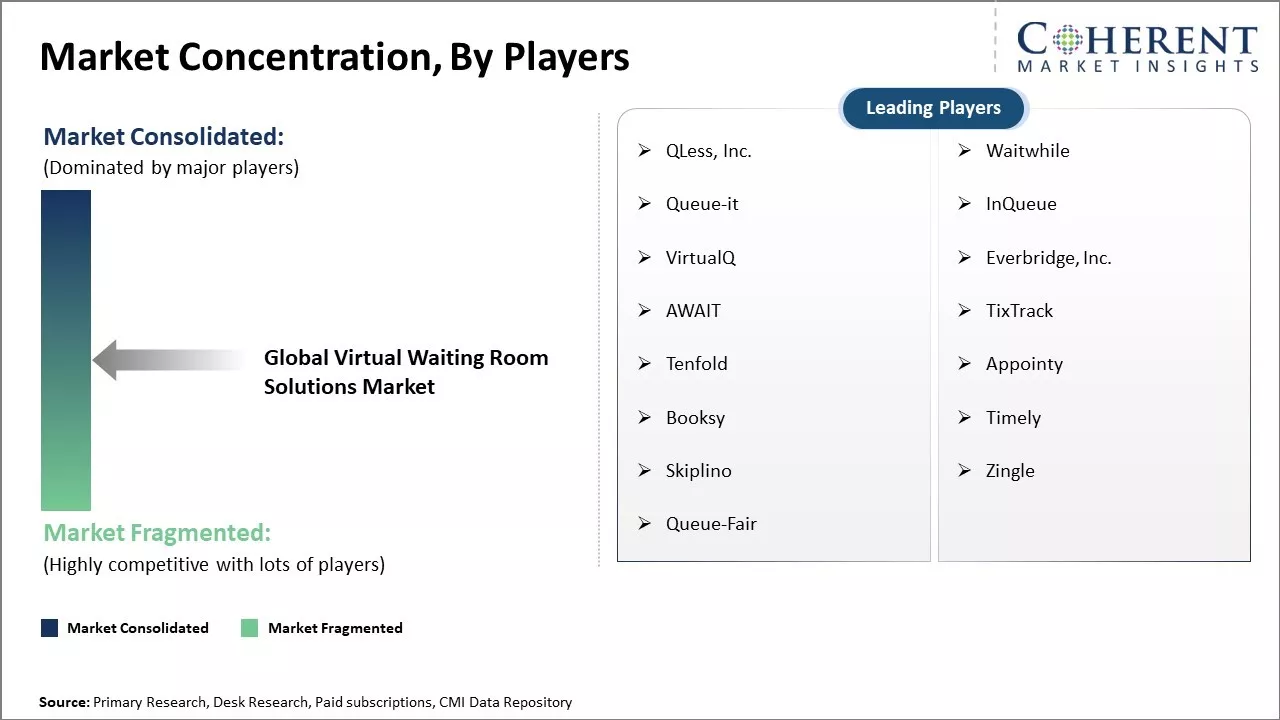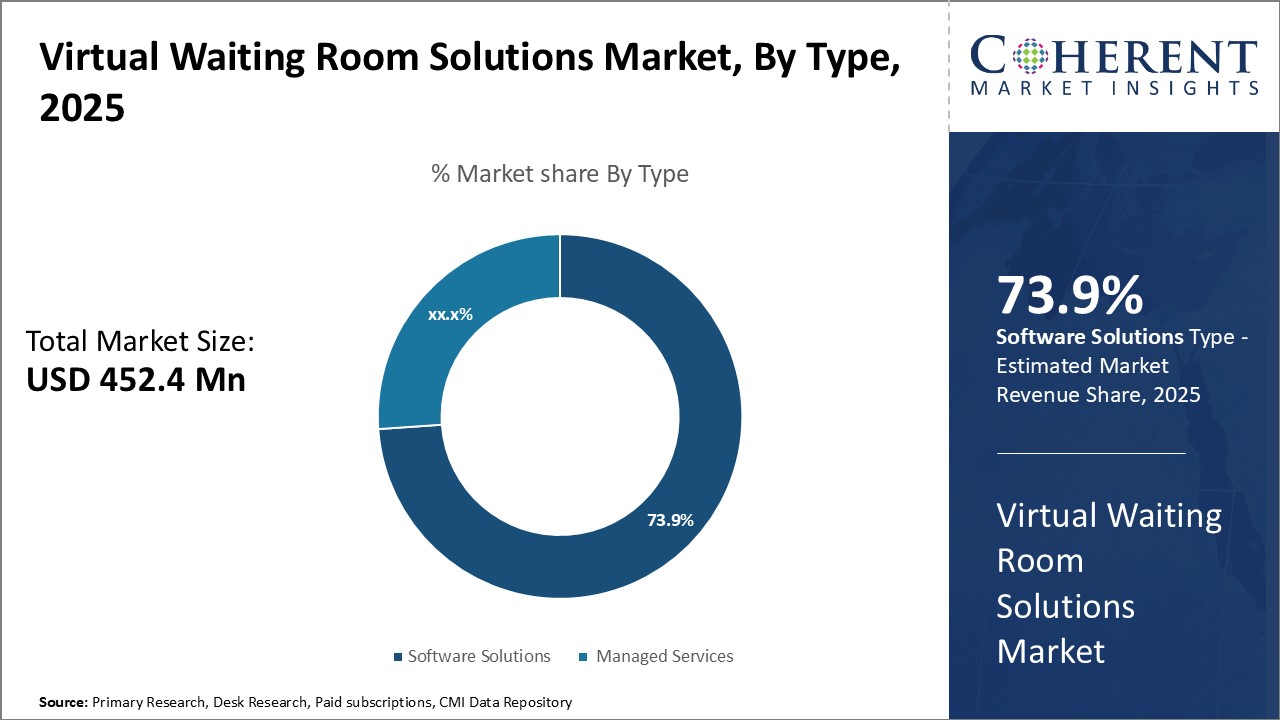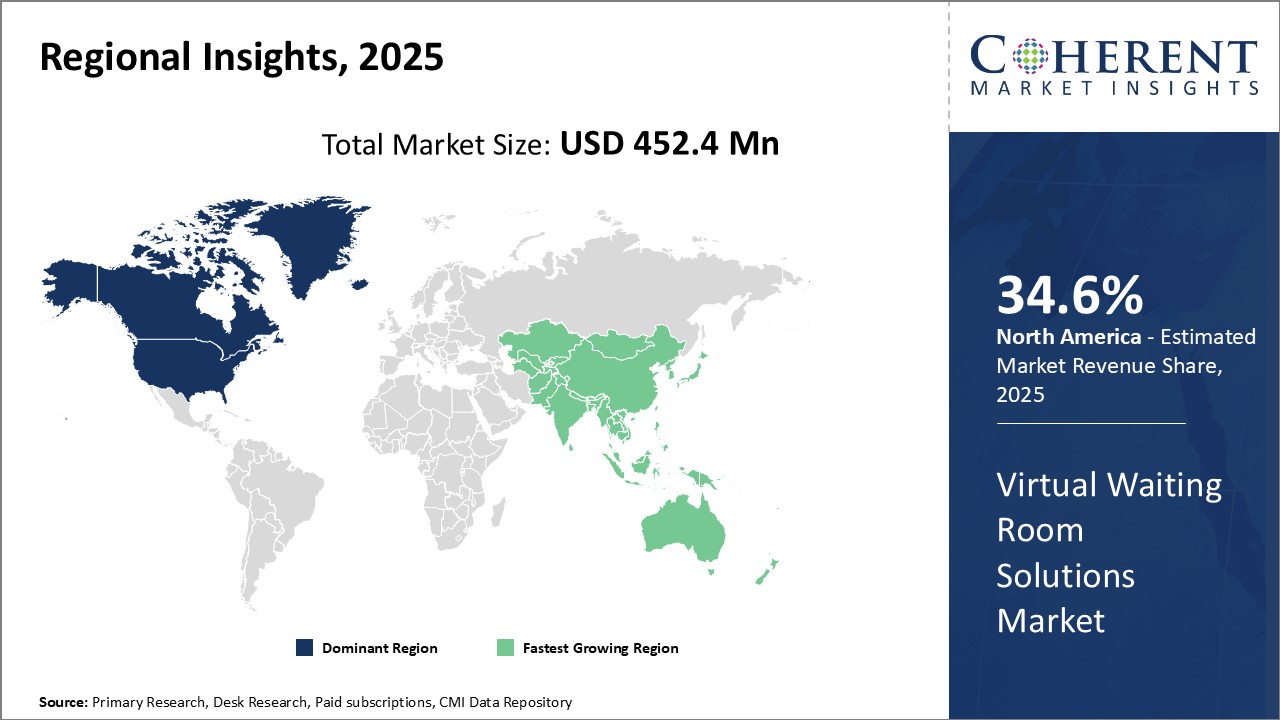Virtual Waiting Room Solutions Market Size and Trends
The global virtual waiting room solutions market is estimated to be valued at US$ 452.4 Mn in 2025 and is expected to reach US$ 2,399.0 Mn by 2032, exhibiting a compound annual growth rate (CAGR) of 26.9% from 2025 to 2032.

Discover market dynamics shaping the industry: Download Free Sample
The rapid rise in virtual care due to the COVID-19 pandemic has accelerated the need for virtual waiting room solutions across various healthcare organizations. Virtual waiting room solutions allow patients to register online and wait virtually for their turn without having to physically visit hospitals and clinics. This helps in maintaining social distancing and reduces the chances of infection spread. The increasing demand for self-service registration and virtual queues is driving several healthcare providers and organizations to adopt virtual waiting room solutions. Moreover, growing awareness about the benefits of these solutions such as reducing wait times, improving customer experience, and optimal resource management are further expected to propel the market growth over the next few years.
Increasing adoption of telemedicine and remote healthcare services
Telemedicine and virtual healthcare services have witnessed significant growth in the past few years, driven by various factors such as the increasing aging population, the shortage of healthcare professionals, and the need for convenient and accessible healthcare. One of the key technologies that have gained traction in this context is Virtual Waiting Room Solutions (VWRS). VWRS enable healthcare providers to manage patient appointments, wait times, and communication digitally, reducing the need for physical presence at hospitals or clinics.
In conclusion, the increasing adoption of telemedicine and remote healthcare services is driving the growth of Virtual Waiting Room Solutions market. The trend is expected to continue, as patients become more accustomed to the convenience and accessibility of remote healthcare services. Healthcare providers are increasingly recognizing the benefits of VWRS in managing patient appointments, wait times, and communication more efficiently. The examples from the VA and the NHS illustrate the potential of VWRS in reducing wait times and improving patient experience.
For instance, in August 2021, Waitwhile, a leading provider of virtual waiting room and appointment scheduling solutions for the healthcare industry, announced the acquisition of its competitor, Qminder. This strategic move is aimed to expand Waitwhile's market reach and solidify its position as a premier patient engagement platform in the healthcare sector.
Market Concentration and Competitive Landscape

Get actionable strategies to beat competition: Download Free Sample
Growing need for efficient patient management and reduced wait times
The healthcare industry is undergoing a significant transformation, driven in part by the growing need for efficient patient management and reduced wait times. Virtual waiting room solutions have emerged as a promising response to these challenges, enabling healthcare providers to streamline their operations and enhance the patient experience.
Virtual waiting rooms allow patients to check-in online, receive real-time updates on wait times, and even complete necessary forms and paperwork before arriving at the clinic. This not only reduces the physical presence of patients in the waiting room, but also allows healthcare providers to better manage their patient flow and optimize staff utilization.
The growing need for efficient patient management and reduced wait times is driving the adoption of virtual waiting room solutions in the healthcare industry. Current trends, such as the COVID-19 pandemic and the increasing investment in telehealth technologies, further underscore the importance of virtual waiting rooms.
Key Takeaways from Analyst:
With social distancing becoming the new norm due to the pandemic, the need for contactless healthcare solutions has increased tremendously. Virtual waiting rooms allow patients to easily check-in online and wait from the comfort of their home, thereby reducing contact between patients in physical waiting areas. This driver of social distancing will continue to propel the adoption of virtual waiting room technology globally.
However, low digital literacy among certain demographics and lack of awareness about these solutions, especially in developing regions, may hinder the market's growth to some extent. Additionally, compatibility issues of virtual systems with legacy healthcare IT infrastructure and privacy concerns could also act as challenges.
Nevertheless, the market will witness numerous opportunities arising from increasing investments by governments and vendors in telehealth and digital health technologies. Furthermore, integration of virtual care capabilities with EHR and patient portal software will enhance user convenience. We expect the Asia Pacific region to emerge as the fastest growing regional market due to rising medical tourism, growing middle class, and government initiatives to push digital transformation in healthcare across countries like India and China.
In conclusion, virtual waiting room solutions are poised for steady growth while addressing the critical need for contactless patient check-in experiences.
Market Challenge - Lack of standardization and interoperability issues
Lack of standardization and interoperability issues is one of the major challenges restraining the growth of the global virtual waiting room solutions market. When there are no common standards and systems cannot talk to each other seamlessly, it leads to numerous inefficiencies. Virtual waiting room solutions implemented by different vendors use varying technologies and protocols. As a result, virtual waiting rooms developed on one platform cannot be seamlessly integrated with other business applications, medical records, scheduling or payment systems that use different standards. This creates data silos and disruptions in workflow. For example, a virtual triage solution introduced by one vendor may not be able to exchange patient details with an electronic health record system developed by another vendor if they do not have compatible standards. This leads to doctors and clinicians having to manually re-enter patient information, increasing the likelihood of errors.
The lack of integrated and standardized experiences negatively impacts productivity, care coordination, and makes the transition to virtual settings difficult. Healthcare providers are reluctant to invest in point solutions that do not offer interoperability. This has prevented larger scale commercial adoption of these technologies. Even during the COVID-19 pandemic, when virtual solutions saw increased demand, interoperability issues limited their integration with existing infrastructure.
Market Opportunity - Integration with AI and machine learning for personalized patient experiences
Integration with AI and machine learning for personalized patient experiences could be a significant opportunity in the global virtual waiting room solutions market going forward. With advancements in ML and AI technologies, virtual waiting room software providers can now offer highly customized patient journeys. By integrating patient data sources like medical records, prescription histories etc., AI/ML algorithms can understand individual patient profiles and needs. This allows for personalized communications, wayfinding assistance, tailored resource recommendations, and more human-like engagement while patients wait virtually.
As patients grow accustomed to customized digital experiences across other sectors, they will expect similar personalization from their healthcare providers as well. AI-powered virtual waiting helps meet these rising expectations by delivering seamless, empathetic experiences. It ensures patients feel seen, informed and in control even when not physically with a clinician. This leads to improved satisfaction, adherence to treatment plans and ultimately better health outcomes. For healthcare organizations, it strengthens patient loyalty and promoter scores.

Discover high revenue pocket segments and roadmap to it: Download Free Sample
Insights By Type - Software Solutions Dominate Due to Customizability and Scalability
In terms of type, software solutions is expected to contributes 73.9% share of the market in 2025 owing to its flexibility and scalability. Software solutions offer clients the ability to customize features as per their exact needs and business requirements. They can be tailored to accommodate workflow variations across different practices, departments, specialties or locations. Software providers typically offer flexible subscription and licensing models so clients can start small and scale up features and users as their needs evolve. This allows healthcare providers and other clients to manage costs effectively over the long run.
Software solutions also ensure seamless integration with existing patient databases, scheduling and billing systems. They come equipped with Application Programming Interfaces (APIs) that facilitate quick and cost-effective integration. This single source of truth for all patient interactions helps streamline operations. Software vendors regularly roll out feature and functionality upgrades through automatic updates. This allows clients to benefit from the latest innovations without incurring extra expenditures. The virtual nature of software deployments also means there is no physical hardware to maintain. Remote troubleshooting and technical support further reduce maintenance overhead.
Compared to complete outsourcing of virtual waiting room services, an on-premise software deployment affords clients greater autonomy and control. They can dictate privacy and security policies as per regulatory mandates. Customizable branding and personalization options using an in-house software strengthen patient and customer relationships through a consistent omni-channel experience. Overall, software solutions emerge as the most versatile and scalable type to efficiently handle fluctuating and growing needs of healthcare providers, retailers, and event organizers.
For instance, in March 2021, QLess, a prominent provider of virtual waiting room solutions based in U.S., launched a new version of its software featuring enhanced analytics capabilities. This update aims to empower businesses, particularly in the healthcare sector, to better understand customer flow and optimize their operations.
Insights By Deployment - Cloud Deployments Lead in Ubiquity and Flexibility
In terms of deployment, cloud-based expected to contributes 62.3% of the market share in 2025 owing to compelling advantages over on-premise models. Cloud infrastructures ensure virtual waiting room services are available anywhere, anytime through any internet-enabled device. This becomes critical in healthcare where facilities need to seamlessly triage and attend to patients who present as walk-ins or arrive via ambulance. The ability to access functionalities from multiple endpoints greatly enhances responsiveness and care quality.
Cloud models are also more cost-effective for clients as they eliminate upfront capital expenditures on servers and other hardware. Variable usage-based pricing matches expenditures closely with real consumption. Resources can be rapidly scaled up or down on-demand to cope with seasonality or surge volumes. Furthermore, cloud providers are responsible for maintaining systems, applying security patches, software upgrades and disaster recovery plans. This frees internal IT teams of clients to focus on core competencies. Periodic software-as-a-service (SaaS) subscription fees also include 24/7 global technical support at no additional cost.
The ubiquitous accessibility of cloud platforms gives patients and customers flexibility to engage from any location prior to on-site visits. Real-time location-based notifications improve convenience. For healthcare, remote check-ins help triage less critical cases and redirect them to alternative care channels like telehealth when appropriate. Overall, cloud deployments emerge highly suitable for the distributed, mobile nature of modern engagements in key application segments like healthcare, retail and events.
Insights By Application - Healthcare Captures Largest Share due to Aging Population and Reimbursement Changes
In terms of application, healthcare expected to contributes 40.6% share of the virtual waiting room solutions market in 2025. This can be attributed to aging demographic trends and reimbursement model changes across developed countries. With senior citizen populations growing rapidly worldwide, healthcare infrastructure is facing immense pressure. Virtual waiting solutions help optimize existing capacity through better scheduling and reduced no-shows. They facilitate easy self-check-ins for routine appointments using any device.
Additionally, tightening reimbursements by governments and insurance providers are compelling healthcare organizations to enhance operational efficiency. Virtual waiting rooms improve patient throughput by directing walk-ins to alternatives like telemedicine for non-emergency cases. This curbs unnecessary emergency department visits that are more costly. Simultaneously, they enhance user experience through seamless communication regarding wait times, service updates and cross-selling of additional wellness offerings.
Rising popularity of multi-speciality healthcare centres and medical tourism is also propelling demand. Virtual check-ins promote convenient one-stop services across a wide spectrum of outpatient specialties under one roof. The growing preference for non-invasive treatments and wellness regimens further amplifies commercial opportunities for healthcare providers. Overall, the application proves highly suitable to address key industry challenges of aging population burden, reduced reimbursements, and patient-centric transformation initiatives.
Regional Insights

Need a Different Region or Segment? Download Free Sample
North America has been dominating the global virtual waiting room solutions market. The region is expected to hold 34.6% of the market share in 2025 owing to a strong presence of key players in the region. Being an early adopter of advanced technologies, the U.S. and Canada have seen high penetration of virtual waiting room solutions across various end-use industries like healthcare, BFSI, retail, and e-commerce over the past few years. Furthermore, high internet penetration, developed digital infrastructure and growing awareness about benefits of queue management systems have been driving the North American virtual waiting room solutions market.
Another fastest growing regional market has been Asia Pacific due to rapidly developing digital ecosystems in major countries. Rapid digital transformation of traditional industries and rise of e-commerce have been fueling the deployment of virtual waiting room solutions in Asia Pacific. Countries like China, Japan, and India are projected to offer lucrative opportunities for solution providers during the forecast period. Economic expansions and supportive government policies encouraging technology adoption have attracted many foreign investors in the Asia Pacific virtual waiting room solutions market. Local players are also strengthening their presence by catering to the dynamic requirements of small and medium businesses across verticals. However, the solutions pricing is significantly lower in Asia Pacific compared to developed regions due to lower operating costs of regional players and higher price sensitivity of end-users.
The Middle East & Africa region has emerged as an emerging hotspot for virtual waiting room solutions over the recent years on account of increasing digitalization initiatives of governments. Major Gulf nations as well as countries like South Africa and Nigeria have seen rising citizen enrolment for e-government services which require efficient online queue management. While digital infrastructure is still at a nascent stage in many African countries, GCC countries have advanced networks comparable to western standards.
Market Report Scope
Virtual Waiting Room Solutions Market Report Coverage
| Report Coverage | Details | ||
|---|---|---|---|
| Base Year: | 2024 | Market Size in 2025: | USD 452.4 Mn |
| Historical Data for: | 2020 To 2024 | Forecast Period: | 2025 To 2032 |
| Forecast Period 2025 to 2032 CAGR: | 26.9% | 2032 Value Projection: | USD 2,399.0 Mn |
| Geographies covered: |
|
||
| Segments covered: |
|
||
| Companies covered: |
QLess, Inc., Waitwhile, Queue-it, InQueue, VirtualQ, Everbridge, Inc., AWAIT, TixTrack, Tenfold, Appointy, Booksy, Timely, Skiplino, Zingle, and Queue-Fair |
||
| Growth Drivers: |
|
||
| Restraints & Challenges: |
|
||
Uncover macros and micros vetted on 75+ parameters: Get instant access to report
Virtual Waiting Room Solutions Industry News
- In January 2024, VirtualQ, a leading provider of cloud-based customer engagement solutions, announced its merger with Engage Technologies, a rapidly growing software company specializing in AI-powered customer interaction platforms. This strategic move aims to enhance VirtualQ's service offerings and provide its clients with more advanced tools to engage with their customers effectively.
- In June 2023, InQueue, a leading provider of queue management solutions for the hospitality industry, launched a new mobile application designed to streamline waiting room management for restaurants. This innovative app aims to enhance the customer experience by reducing wait times and improving operational efficiency for restaurant staff.
- In February 2023, Everbridge, a global leader in critical event management solutions, expanded its virtual waiting room offerings to cater specifically to large-scale events. This enhancement aims to improve attendee management and streamline the experience for organizers of major gatherings, such as concerts, festivals, and sporting events.
- In November 2022, Queue-it, a leading provider of virtual waiting room services, announced partnerships with several major e-commerce platforms to enhance online queuing capabilities during peak sales periods. These collaborations aim to help retailers and brands manage website traffic surges effectively, ensuring a smooth and fair experience for customers while driving sales.
*Definition: The global virtual waiting room solutions market provides software that allows organizations to manage high volumes of incoming calls, website visitors, or customers and distribute them in an organized way without them having to wait endlessly on hold. These virtual waiting room solutions offer queue management, call/visitor prioritization, customized on-hold messaging, and estimation of wait times to improve customer experience. They help businesses streamline operations, reduce bottlenecks and keep customers engaged while waiting to be serviced either via phone, online chat, etc.
Market Segmentation
- Type Insights (Revenue, US$ Mn, 2020 - 2032)
-
- Software Solutions
- Managed Services
- Deployment Insights (Revenue, US$ Mn, 2020 - 2032)
-
- Cloud-based
- On-premises
- Application Insights (Revenue, US$ Mn, 2020 - 2032)
-
- Healthcare
- E-Commerce
- Events and Entertainment
- Education
- Others
- By Regional Insights (Revenue, USD Mn 2020 - 2032)
- North America
- U.S.
- Canada
- Latin America
- Brazil
- Argentina
- Mexico
- Rest of Latin America
- Europe
- Germany
- U.K.
- Spain
- France
- Italy
- Russia
- Rest of Europe
- Asia Pacific
- China
- India
- Japan
- Australia
- South Korea
- ASEAN
- Rest of Asia Pacific
- Middle East
- GCC Countries
- Israel
- Rest of Middle East
- Africa
- South Africa
- North Africa
- Central Africa
- North America
- Key Players Insights
-
- QLess, Inc.
- Waitwhile
- Queue-it
- InQueue
- VirtualQ
- Everbridge, Inc.
- AWAIT
- TixTrack
- Tenfold
- Appointy
- Booksy
- Timely
- Skiplino
- Zingle
- Queue-Fair
Share
Share
About Author
Ankur Rai is a Research Consultant with over 5 years of experience in handling consulting and syndicated reports across diverse sectors. He manages consulting and market research projects centered on go-to-market strategy, opportunity analysis, competitive landscape, and market size estimation and forecasting. He also advises clients on identifying and targeting absolute opportunities to penetrate untapped markets.
Missing comfort of reading report in your local language? Find your preferred language :
Transform your Strategy with Exclusive Trending Reports :
Frequently Asked Questions
EXISTING CLIENTELE
Joining thousands of companies around the world committed to making the Excellent Business Solutions.
View All Our Clients
